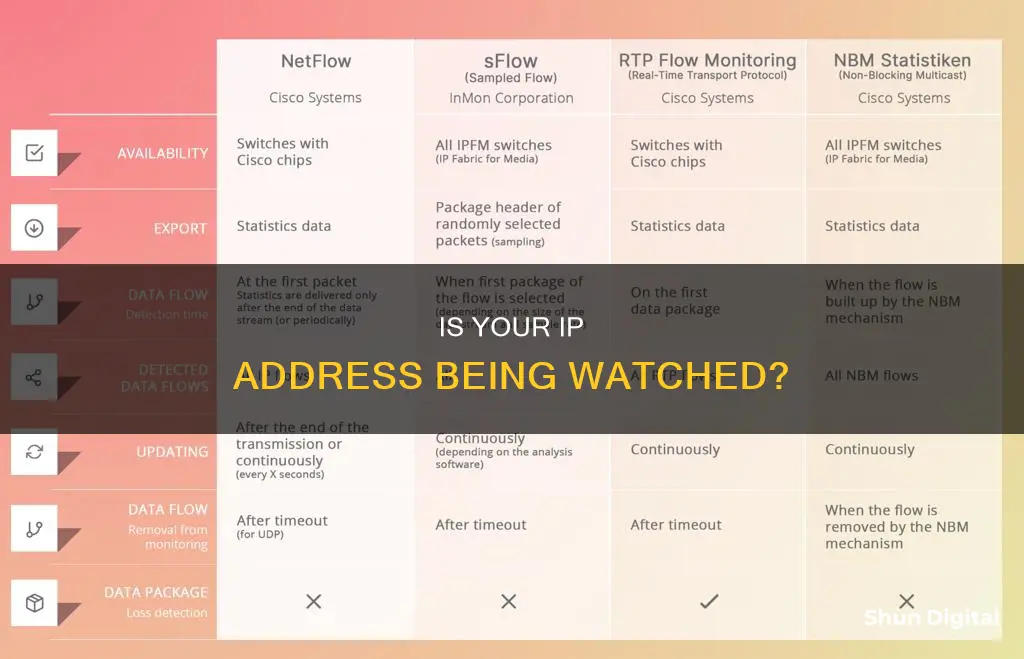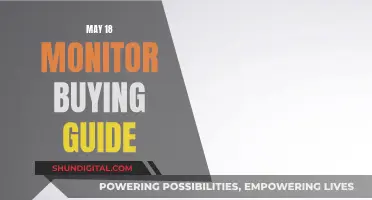
In today's digital world, concerns about online privacy and surveillance are on the rise. Many people worry about whether their internet activities are being monitored, especially their IP address, which serves as their online identity. While there is no single way to determine if your IP address is being monitored, there are several signs and techniques to help you detect potential surveillance.
Unusual network activity, such as sudden drops in internet speed, frequent network interruptions, unexplained data usage spikes, and unexpected software installations, could indicate that your IP address is under surveillance. Monitoring your outgoing traffic using tools like netstat can help identify any suspicious IP addresses.
Additionally, behavioural anomalies, such as targeted advertisements that seem too specific to your recent online activities, out-of-place online recommendations, and a sudden influx of suspicious emails, may also suggest potential IP address monitoring.
To protect your online privacy and mitigate the risk of IP address monitoring, consider using encryption tools, regularly changing passwords, employing virtual private networks (VPNs), and staying cautious of suspicious online activities.
| Characteristics | Values |
|---|---|
| Unusual Network Activity | Sudden drops in internet speed, frequent network interruptions, unexplained data usage spikes, warnings from your internet service provider about exceeding data limits, unfamiliar devices connected to your Wi-Fi network, unexpected software installations or browser extensions, constant DNS errors, internet traffic being redirected to unfamiliar websites, frequent SSL certificate warnings |
| Tools and Techniques | Network monitoring software, port scan, IP tracking websites |
| Unexplained Slow Internet Connection | Constant buffering |
| Tracking Cookies and Online Ads | Targeted advertisements, "retargeting" |
| Behavioral Anomalies | Ads targeting specific interests, out-of-place online recommendations, a sudden influx of suspicious emails, inexplicable changes in website preferences or settings, unexpected redirection to unknown websites |
| Suspicious Emails and Phishing Attempts | Deceptive emails that mimic legitimate organizations or individuals, misspellings, generic greetings, urgent requests for personal information, suspicious attachments or links |
What You'll Learn

Unusual network activity
Detecting Unusual Network Activity:
- Monitor your network traffic: Use tools like Netstat to generate a list of outgoing data transmissions and their IP addresses. Look for any unfamiliar IP addresses or destinations that don't correspond to your regular online activity.
- Scan your network for unknown devices: Utilize free network scanning applications or deploy deep packet inspection (DPI) tools to passively identify all devices connected to your network.
- Check your MAC address: Network switches maintain a list of MAC addresses associated with specific network switch ports. Track down any unknown devices using their MAC addresses.
- Check your IP address blacklist status: Use services like IPVOID to see if your IP address has been blacklisted due to suspicious activity.
- Monitor your internet gateway: Keep an eye on network scans, traffic on unusual port numbers, and Tor traffic.
Addressing Unusual Network Activity:
- Disconnect from a VPN: If you're using a VPN, temporarily disconnect from it. VPNs can trigger unusual traffic errors due to shared IP addresses and the routing of traffic through multiple servers.
- Limit your searches and search operators: Reduce the number of searches you're performing in a short period, especially if you're using automated tools or advanced search operators.
- Scan for malware: Use trusted antivirus software to scan your device for any malware or suspicious programs. Remove any malicious software and change your passwords.
- Contact your ISP: If you can't find any issues or resolve the unusual activity, reach out to your internet service provider for further assistance. You may need to request an IP address change if your current one is compromised.
Choosing the Right External Monitor Cable for Your GH5
You may want to see also

Tools and techniques to check for surveillance
There are several tools and techniques available to help detect surveillance on your IP address. Here are some methods you can use:
Network Monitoring Software
Network monitoring software can track all network traffic and provide information about the devices connected to your network. By analyzing this data, you can identify any suspicious activity that may indicate IP address monitoring.
Port Scan
Conducting a port scan allows you to check for any open and vulnerable ports on your network. If you find open ports that you don't recognize or need, it could suggest that someone is attempting to gain unauthorized access to your system.
IP Tracking Websites
IP tracking websites can provide details such as your geographical location, Internet Service Provider (ISP), and the type of device you are using. Any inconsistencies or unknown information may indicate that your IP address is being monitored.
Diagnostic Tests for Slow Internet Connection
If you experience a significant and persistent decrease in your internet speed, it could be a sign of IP address monitoring. To determine this, you can perform diagnostic tests by checking your internet speed with online tools and comparing it to your provider's advertised speed. If there is a significant discrepancy, it may suggest surveillance.
Ad-Blocking Extensions and VPNs
To detect surveillance via tracking cookies and online ads, you can use ad-blocking browser extensions, regularly clear your browser cookies, or use a Virtual Private Network (VPN) to mask your IP address and protect your online privacy.
Online Tools
Online tools like IP Logger or IP Lookup can help gather information about your IP address usage and detect any suspicious activities.
Software Programs
Software programs like Wireshark and GlassWire can assist in analyzing your network traffic and identifying any unusual activities that may indicate IP address monitoring.
Antivirus Programs
Consider installing a reputable antivirus program like Norton 360, which can scan your device for suspicious files and programs. It can also provide real-time threat protection by blocking malicious links and attachments.
Monitoring Active Internet Connections
By using tools like TCPView, you can monitor all your internet connections and identify any strange or unauthorized activities.
Task Manager or Activity Monitor
Keep an eye on your task manager or activity monitor. If it becomes disabled or you notice suspicious processes consuming a lot of resources, it could indicate potential IP address monitoring.
Regular Checks
Perform regular "check-ups" on your device's temperature, browser activity, active connections, and webcam permissions. Be vigilant about any unusual behavior or unauthorized access.
By utilizing these tools and techniques, you can proactively protect your online privacy and enhance the security of your IP address.
Latest ASUS Monitors: Top Picks for 2023
You may want to see also

Slow internet connection
A slow internet connection could be the result of spyware or viruses on your computer. Spyware can slow your system by interfering with your browser and monopolizing your internet connection. It does this by monitoring your internet use and keystrokes, which adds delays. If multiple spyware programs are running simultaneously, you could lose connectivity altogether.
Computer viruses can also cause poor internet performance. When a virus infects a computer, it installs computer code that attempts to propagate itself, usually by sending copies of itself through email. Some viruses can multiply at the rate of hundreds of emails per minute, leaving little computing power and internet connection bandwidth for anything else.
You can also check for spyware or viruses by using a reputable antivirus program. Norton 360, for example, can scan your device and root out suspicious files and programs.
Another potential cause of a slow internet connection is a congested home network. This happens when you overload your internet connection with more traffic than it can handle. To fix this, you can either lower your internet usage or upgrade to a faster plan.
Your internet connection may also be slow due to a weak Wi-Fi signal. This can be caused by being too far from your router, or by signal interference from other Wi-Fi networks and electronic devices. To fix this, you can try extending your Wi-Fi range, choosing a better spot for your router, or adjusting your router's settings.
Your internet connection may also be slow due to high latency. High latency creates noticeable lag and can be particularly frustrating for online gaming and video calls. Unfortunately, this can be difficult to work around, as it depends on your physical distance from internet servers, network congestion, and your internet provider's infrastructure.
Ornate Monitor Growth: Full Size, How Fast?
You may want to see also

Tracking cookies and online ads
Tracking cookies, also known as third-party marketing cookies, are small text files placed on your device by websites you visit. They track your online activity, including the websites you visit, the pages you view, the links you click, the products you purchase, and the searches you perform. This information is then used to show you targeted ads, collect analytical data, or improve your user experience.
Tracking cookies are often set by third-party companies, such as advertising networks and social media platforms. These companies can see which websites you have visited and what products or services you are interested in. This information is then used to display targeted ads on other websites. For example, if you visit a website that sells shoes and look at a pair of running shoes, the website may set a tracking cookie. This cookie will then track your activity across other websites, and you may see ads for running shoes on different websites.
While tracking cookies can be useful for businesses and consumers, they have also raised privacy concerns. Some people are uncomfortable with the idea of companies tracking their online activity without their consent. Additionally, tracking cookies can be used by malicious actors to steal personal information. In response to these concerns, data privacy laws such as the General Data Protection Regulation (GDPR) in the European Union and the California Consumer Privacy Act (CCPA) in the United States have been implemented, requiring businesses to obtain user consent before placing tracking cookies.
Users can manage and block tracking cookies through browser settings, cookie blockers, ad blockers, or the Do Not Track browser setting. However, it is important to note that blocking tracking cookies may result in a less personalized browsing experience, with fewer relevant ads and personalized recommendations.
Monitors: VGA vs. HDMI — Which Connection is Superior?
You may want to see also

Suspicious emails and phishing attempts
Phishing is a common method used by cybercriminals to lure unsuspecting users into giving up their personal information. Phishing attempts can come in the form of emails, social media posts, direct messages, phone calls, texts, and messaging services. These messages often try to create a sense of urgency or make an offer that is too good to be true. For example, they may claim that your email account has been compromised, offer free Disney World tickets, or ask you to review an attached document.
- Suspicious sender's address: The sender's address may imitate a legitimate business by using an email address that closely resembles one from a reputable company, with minor alterations or omissions in the spelling.
- Generic greetings and signature: A generic greeting, such as "Dear Valued Customer," or a lack of contact information in the signature block, can indicate a phishing attempt. Reputable organizations will typically address you by name and provide their contact details.
- Spoofed hyperlinks and websites: Hovering your cursor over any links in the email body may reveal that the link is spoofed. Malicious websites may have a similar appearance to legitimate sites but with slight variations in the URL, such as using a different domain (.com vs. .net).
- Poor spelling and grammar: Reputable institutions usually have dedicated staff to review and proofread customer correspondence. An email with misspellings, inconsistent formatting, or poor grammar may be a phishing attempt.
- Suspicious attachments: Be cautious of unsolicited emails requesting that you download or open attachments. Cybercriminals may create a false sense of urgency or importance to persuade you to open attachments without examining them first.
- Requests for personal information: Legitimate businesses should not ask you to send passwords, login names, social security numbers, or other sensitive information through email.
- Unusual sense of urgency: Phishing emails often try to convey a sense of urgency to prompt immediate action without giving you time to think. Be cautious of phrases like "If you don't respond within 48 hours, your account will be closed."
If you suspect a phishing attempt, do not click on any links or reply to the email. Instead, report the email to the relevant authorities, such as your IT department or security officer. You can also block the sender and delete the email. Additionally, you can report phishing attempts to organizations like the Federal Trade Commission (FTC) or the Anti-Phishing Working Group (APWG).
Cleaning an LCD Monitor: Streak-Free Tips and Tricks
You may want to see also
Frequently asked questions
Unusual network activity, such as sudden drops in internet speed, frequent network interruptions, unexplained data usage spikes, and unfamiliar devices connected to your Wi-Fi network, can indicate potential IP address monitoring.
You can use network monitoring software to analyse network traffic and identify any suspicious activity. Conducting a port scan can also help identify any open and vulnerable ports on your network.
While having your IP address publicly available doesn't pose an immediate risk, it can be used maliciously in combination with other information. For example, if you have malicious software installed, a third party could gain access to your data.
You can use a proxy server or a virtual private network (VPN) to mask your IP address and enhance your online privacy. Additionally, regularly updating your security software, using encryption tools, and being cautious of suspicious online activities can help protect your IP address from being monitored.







